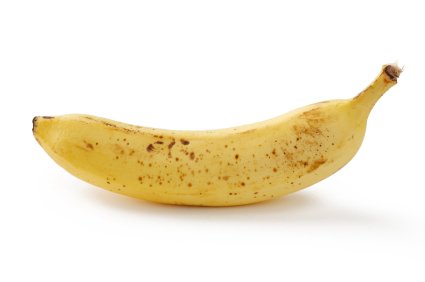So, is a banana safe to eat if you’re following the low FODMAP diet? Here’s the answer…
- An unripe banana (100g) is low in oligo-fructans, making it safe to eat on a low FODMAP diet.
- A ripe banana is high in oligo-fructans, making it high in FODMAPs. However, a third of a ripe banana (33g) should be tolerated by most individuals with IBS.
I thought a banana was low FODMAP?
As of May 2017, a banana is no longer classed as low FODMAP. Instead, a distinction is made between ripe and unripe bananas. See the quote below from Monash University for more information.
Why has the FODMAP rating of bananas changed ?
We know that agricultural and environmental factors influence FODMAP levels in food and believe that the changes in our FODMAP results may reflect this. From published research we know that plants naturally tend to accumulate fructans in response to environmental stressors such as cold temperatures and drought.(1)
Fructans provide plant cells with greater structural integrity, making them more hardy and resistant to damage from environmental changes and disease.(1) Studies investigating bananas specifically have found that their fructan content increases when they are stored and ripened in cold storage, which is now relatively common practice by supermarket chains to prevent spoilage and guarantee even ripening.(2, 3) Farmers may also be selectively breeding varieties of crops with a higher fructan content, as they tend to be more resilient to pests and diseases.(1)
Source: Monash University 2017
An entire ripe banana (100g) and even half a ripe banana (50g) is high in Oligos-fructans and should be avoided.
Need more info on the FODMAP diet?
If you’re starting your journey on the low FODMAP diet, you’ll need to know what food is high FODMAP and what food is low FODMAP.
You’ll probably already have heard of the acronym FODMAP (Fermentable, Oligo-, Di-, Mono-saccharides and Polyols) in the context of irritable bowel syndrome (IBS).
Click here to check the low FODMAP food list for more information on other low/high FODMAP foods.
The low FODMAP diet involves cutting out all five families of fermentable carbohydrates: Fructans (wheat, rye, onions, garlic, various other grains and vegetables), Galacto-oligosaccharides (beans and pulses), Polyols (certain fruit, certain artificial sweetners), Fructose (various fruits, honey and agave nectar) and Lactose (animal milks, yoghurts and some cheeses).
Low FODMAP recipes
Cooking to suit a low FODMAP diet can be tricky at first, but I’ve created recipes for breakfast, lunch and dinner. There’s also a few baking recipes thrown there too! Cooking without high FODMAP foods is easy when you now how, so these recipes are a great place to start.
- Breakfast Frittata
- Chocolate Lava Cake
- Yorkshire Puddings
- Chicken Stew and Dumplings
- Low FODMAP Curry Powder
- Cream of Chicken Soup
- Herb-Crusted Cod and Tartar Sauce
- Chewy ginger biscuits
- Chinese Chicken Curry
4 IBS Hacks You Need To Know
Got any questions? Be sure to leave me a comment below…

